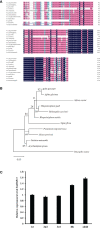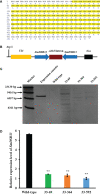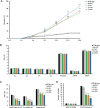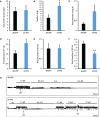Silencing an aphid-specific gene SmDSR33 for aphid control through plant-mediated RNAi in wheat
- PMID: 36699834
- PMCID: PMC9868936
- DOI: 10.3389/fpls.2022.1100394
Silencing an aphid-specific gene SmDSR33 for aphid control through plant-mediated RNAi in wheat
Abstract
Grain aphid (Sitobion miscanthi) is one of the most dominant and devastating insect pests in wheat, which causes substantial losses to wheat production each year. Engineering transgenic plants expressing double strand RNA (dsRNA) targeting an insect-specific gene has been demonstrated to provide an alternative environmentally friendly strategy for aphid management through plant-mediated RNA interference (RNAi). Here we identified and characterized a novel potential RNAi target gene (SmDSR33) which was a gene encoding a putative salivary protein. We then generated stable transgenic wheat lines expressing dsRNA for targeted silencing of SmDSR33 in grain aphids through plant-mediated RNAi. After feeding on transgenic wheat plants expressing SmDSR33-dsRNA, the attenuated expression levels of SmDSR33 in aphids were observed when compared to aphids feeding on wild-type plants. The decreased SmDSR33 expression levels thus resulted in significantly reduced fecundity and survival, and decreased reproduction of aphids. We also observed altered aphid feeding behaviors such as longer duration of intercellular stylet pathway and shorter duration of passive ingestion in electroneurography assays. Furthermore, both the surviving aphids and their offspring exhibited decreased survival rates and fecundity, indicating that the silencing effect could be persistent and transgenerational in grain aphids. The results demonstrated that SmDSR33 can be selected as an effective RNAi target for wheat aphid control. Silencing of an essential salivary protein gene involved in ingestion through plant-mediated RNAi could be exploited as an effective strategy for aphid control in wheat.
Keywords: RNA interference (RNAi); aphid control; grain aphid (Sitobion miscanthi); salivary protein; wheat (Triticum aestivum L).
Copyright © 2023 Zhang, Li, Zhong, Tian, Segers, Xia and Francis.
Conflict of interest statement
The authors declare that the research was conducted in the absence of any commercial or financial relationships that could be construed as a potential conflict of interest.
Figures





Similar articles
-
Identifying potential RNAi targets in grain aphid (Sitobion avenae F.) based on transcriptome profiling of its alimentary canal after feeding on wheat plants.BMC Genomics. 2013 Aug 16;14:560. doi: 10.1186/1471-2164-14-560. BMC Genomics. 2013. PMID: 23957588 Free PMC article.
-
RNA Interference of the Ecdysone Receptor Genes EcR and USP in Grain Aphid (Sitobion avenae F.) Affects Its Survival and Fecundity upon Feeding on Wheat Plants.Int J Mol Sci. 2016 Dec 14;17(12):2098. doi: 10.3390/ijms17122098. Int J Mol Sci. 2016. PMID: 27983619 Free PMC article.
-
Salivary Effector Sm9723 of Grain Aphid Sitobion miscanthi Suppresses Plant Defense and Is Essential for Aphid Survival on Wheat.Int J Mol Sci. 2022 Jun 21;23(13):6909. doi: 10.3390/ijms23136909. Int J Mol Sci. 2022. PMID: 35805913 Free PMC article.
-
RNAi-mediated plant protection against aphids.Pest Manag Sci. 2016 Jun;72(6):1090-8. doi: 10.1002/ps.4258. Epub 2016 Mar 21. Pest Manag Sci. 2016. PMID: 26888776 Review.
-
Engineering plants for aphid resistance: current status and future perspectives.Theor Appl Genet. 2014 Oct;127(10):2065-83. doi: 10.1007/s00122-014-2371-2. Epub 2014 Aug 24. Theor Appl Genet. 2014. PMID: 25151153 Review.
Cited by
-
Supramolecular chemistry for optical detection and delivery applications in living plants.Chem Soc Rev. 2025 Aug 26;54(17):7769-7869. doi: 10.1039/d4cs00500g. Chem Soc Rev. 2025. PMID: 40673397 Free PMC article. Review.
-
Roles of herbivorous insects salivary proteins.Heliyon. 2024 Apr 3;10(7):e29201. doi: 10.1016/j.heliyon.2024.e29201. eCollection 2024 Apr 15. Heliyon. 2024. PMID: 38601688 Free PMC article. Review.
-
Toward invasive mussel genetic biocontrol: Approaches, challenges, and perspectives.iScience. 2023 Sep 28;26(10):108027. doi: 10.1016/j.isci.2023.108027. eCollection 2023 Oct 20. iScience. 2023. PMID: 37860763 Free PMC article. Review.
-
RNAi turns 25:contributions and challenges in insect science.Front Insect Sci. 2023 Oct 4;3:1209478. doi: 10.3389/finsc.2023.1209478. eCollection 2023. Front Insect Sci. 2023. PMID: 38469536 Free PMC article. Review.
References
-
- Bachman P. M., Bolognesi R., Moar W. J., Mueller G. M., Paradise M. S., Ramaseshadri P., et al. . (2013). Characterization of the spectrum of insecticidal activity of a double-stranded RNA with targeted activity against western corn rootworm (Diabrotica virgifera virgifera LeConte). Transgenic Res. 22 (6), 1207–1222. doi: 10.1007/s11248-013-9716-5 - DOI - PMC - PubMed
LinkOut - more resources
Full Text Sources

